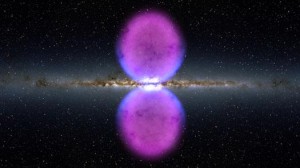
Gamma ray bubbles seen toward the Galactic center extracted by the Harvard team from Fermi telescope data
MSNBC interview on how the superwave theory explains the recently announced Fermi bubbles: http://www.msnbc.msn.com/id/21134540/vp/40152463#40152463
The team of Harvard University scientists who discovered the Fermi bubbles (Su, Slatyer, and Finkbeiner), lean toward the interpretation that the gamma ray emission from the bubbles is synchrotron radiation created by ultra relativistic cosmic ray electrons emitted from the core of our Galaxy. See the draft of their paper posted at: http://arxiv.org/pdf/1005.5480v3. In general, cosmic ray electrons that have energies high enough to produce gamma ray synchrotron radiation have relatively short lifetimes, meaning that they radiate away their energy in a period of time that is short by astronomical standards. On this basis, the Harvard team estimates that these cosmic ray electrons have a “cooling time” of on the order of 10^5 – 10^6 years. In other words, we may conclude that they have been in flight for no more than this long and possibly even a shorter period of time. Thus the bubble would have an age less than this upper limit value, and as I show below, we may determine that the main bubble likely has an age of ~40,000 years.
The Harvard team notes that the outer boundary of the bubble is quite sharply defined and that its interior surface brightness is relatively flat (i.e., uniform). They state this indicates a sharp increase in cosmic ray intensity at the bubble walls. They consider various formation mechanisms and as one likely mechanism have suggested that the emission is the result of a sudden outburst of cosmic ray electrons from our Galaxy’s core; see p. 39 of their preprint. They appear to consider a subrelativistic blast wave type model for the outward propagation of the cosmic rays to the bubble perimeter. However, they note several difficulties in the explanation. The short lifetimes of the cosmic ray electrons would require that they move relatively rapidly outward from the core and second the uniformity of the bubble emission suggests that little time has been available for the nonuniformities to develop in this cosmic ray “wind” due to diffusive effects.
Both of these time limit difficulties are solved if the cosmic ray electrons are assumed to propagate radially away from the galactic core in all directions at very close to the speed of light. In other words, the problems are solved if we assume that these cosmic rays propagate as a superwave.
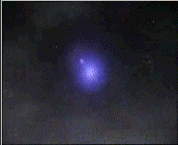
Illustration of a Galactic superwave outburst excerpted from the video Earth Under Fire
A sudden outburst propagating relativistically would also explain why the bubble maintains a sharp outer edge. The synchrotron gamma ray emission we are seeing from the bubble would come from cosmic rays that had been scattered away from their rectilinear outward flight, either by collisions with photons, ionized gas, or due to being captured into spiral orbits around magnetic field lines. In this way their emitted gamma ray synchrotron beams which are directed into very narrow cones aimed in the forward direction of travel (relativistic beaming effect) become visible to us at our near perpendicular viewing direction.
Another difficulty that the Harvard team points out is their interpretation that the bubble is produced by cosmic ray jets emitted from the Galactic core. The point is that you wouldn’t expect to have two jets exactly diameterically opposed to one another. The question they have is why is one jet opposed to the other? This problem too is resolved by the superwave model. The jet model assumes that cosmic rays are emitted as a confined beam in one direction whereas the superwave model assumes isotropic emission forming an spherical superwave shell that expands in diameter as the superwaves move outward. The reason why we see two opposed bubbles is because the cosmic rays aimed upward and downward relative to the galactic plane escape more freely and with greater intensity due to the fact that the torroidal magnetic field surrounding the galactic core does not impede the outward flight of the cosmic rays; see diagram below.
The diffuse gamma ray halo (see image below), which was discovered in 1997 and is seen at high galactic latitudes and in all directions around the galactic disc, is also generated by outward moving superwave cosmic rays.
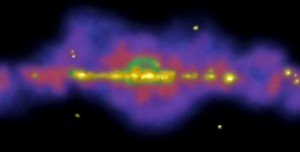
Galactic map showing the Milky Way's diffuse gamma ray halo. Abscissa indicates galactic longitude. (courtesy of D. Dixon, D. Hartmann, E. Kolaczyk, and NASA)
I had pointed this out in 2001 in an updated edition of my Ph.D. dissertation entitled Galactic Superwaves and their Impact on the Earth,
and had described this diffuse gamma emission halo as being additional evidence that we reside within a shell of outward propagating superwave cosmic rays. In describing this emission, astrophysicists in 1997 had noted that the cosmic ray electrons producing this gamma emission have a relatively short lifetime and hence could not be propagating very far from their point of generation. Yet no sources were readily apparent and so they wondered where did these high energy cosmic rays originate from. Dr. Dixon, one of the discovery team stated:
“What is so curious about the newly discovered gamma-ray cloud is that the photons do not appear to be coming from any compact sources, like other galaxies or a black hole. The reason this is interesting is that there isn’t any obvious source for these gamma rays, based on astronomical observations in other wavelengths of light. That is, as far as we can tell using other telescopes, the space around our galaxy is rather empty of the kinds of things which we would expect to generate gamma rays in the observed brightness distribution.”
In 2001 I believe I was the first to point out that the cosmic rays producing this diffuse gamma emission had a galactic core origin. I had pointed out that the cosmic ray origin problem noted by the astronomers discovering the halo could be resolved if we assume that this gamma emission is produced by superwave cosmic rays that have been in flight on the order of 10^4 years or so.
The Fermi bubble emission is part of this omnidirectional diffuse gamma ray halo, but it is brighter than the rest due to the fact that the cosmic ray electrons traveling in the general direction of the Galaxy’s poles encounter less resistance from the Galaxy’s core magnetic field. So in suggesting that the Fermi gamma ray bubbles might be produced by cosmic ray electrons recently emitted from the Galactic core, the Harvard team confirms my earlier proposal about the origin of the cosmic rays energizing the Galaxy’s gamma ray halo.
The Harvard team also acknowledges the existence of fainter larger gamma ray bubbles outside the main inner gamma ray bubble, noting that this points to previous events. They acknowledge that this indicates ongoing cyclic activity on a shorter timescale than had previously been acknowledged. This supports another aspect of the superwave theory that superwaves are recurrent. I have proposed a rather short recurrence period, with major explosions of our galactic core occurring on cycles of 12,000±1000 and 25,000 ±2000 years.
To estimate an age of the gamma ray bubble on the basis of the superwave hypothesis, consider the diagram below.
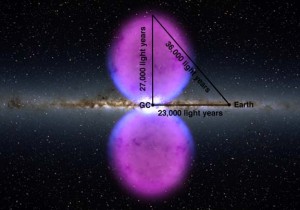
Estimating the age of the bubbles on the basis of the superwave hypothesis.
Knowing that the outer edge of the bubbles extend 50° above and below the Galactic plane, and knowing that we lie ~23,000 light years from the Galactic center, geometry tells us that the outer edges of the bubbles lie about 27,000 light years from the Galactic plane. The hypotenuse distance from the upper edge to us calculates to be 36,000 light years. So Adding 27,000 years for the superwaves speed of light flight upward, plus 36,000 years for the generated gamma emission to reach us gives that the outburst left the core 63,000 years ago. Considering that the same superwave took 23,000 years to reach us, we conclude that the superwave event associated with this gamma ray bubble passed us 40,000 years ago (63k – 23k). When we look at the beryllium-10 ice core record from Vostok, Antarctica, we see that one of the largest magnitude and longest lasting Be-10 peaks is centered at 40,000 years before present; see posted diagram below. In terms of cosmic ray output, it greatly surpasses the smaller ones that passed us at the end of the ice age around 11,000 to 16,000 years ago, these more recent lower magnitude events presumably being responsible for bringing the ice age to a close.
We see a similar double lobe phenomenon going on in other galaxies. For example, X-ray and radio emission lobes are also seen flanking the core of radio galaxy Centaurus A, the closest galaxy to us exhibiting activity in its core; see the photo below.
Emission lobes are also seen flanking the galactic core of the edge-on spiral M82; see the Hubble Space Telescope photo below.
The discovery of the Voorwerp gas cloud also supports the superwave theory that core explosions can turn on and off relatively rapidly, i.e. within tens or hundreds of years. In this case the Voorwerp is observed to be illuminated by light from a quasar in the core of the background spiral galaxy IC 2497 which currently is seen to have a quiescent core; see photo below. Estimates of the light travel time from the galaxy’s core to Voorwerp and then from this cloud to us suggest that galaxy’s core quasar shut off and returned to quiescence sometime within the past 70,000 years.
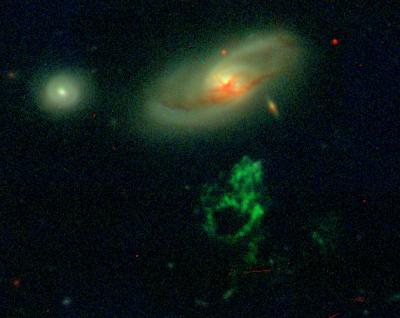
Voorwerp cloud in the foreground is illuminated by light from a quasar in the core of background spiral galaxy IC 2497 that has since shut off. (photo courtesy of WIYN/William Keel/Anna Manning)
See story at: http://www.physorg.com/news/2010-11-cosmic-curiosity-reveals-ghostly-dead.html
The shells imaged recently in galaxy NGC 474 also are evidence of recurrent superwaves propagating isotropically from the cores of active galaxies; see photo below.
In conclusion, I believe that the discovery of the gamma ray bubble provides strong confirmatory evidence for the superwave theory and is corroborated by the ice core evidence.
For information on past confirmations of the superwave model of relativistic, rectilinear cosmic ray propagation see:
http://starburstfound.org/predictions-part-1/
(Prediction No. 2).
Also see the press release at:
http://starburstfound.org/findings-validate-radial-model-galactic-center-cosmic-ray-propagation/.
(You will notice I don’t use the word “black hole” but instead use the more theory-neutral term “galactic core.” I state my opinion about black holes at the following link: http://starburstfound.org/mother-star-gravity-well/.)
Paul LaViolette, Ph.D.
The Starburst Foundation

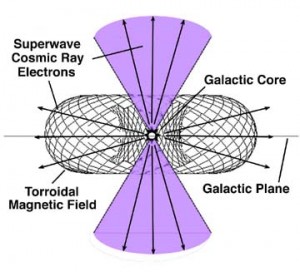
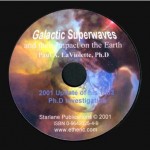

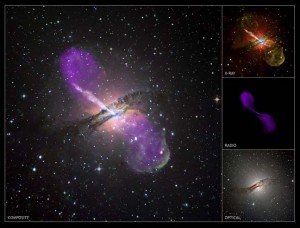
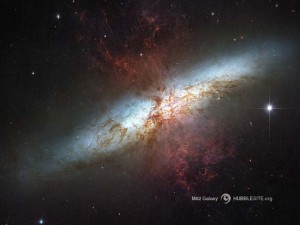
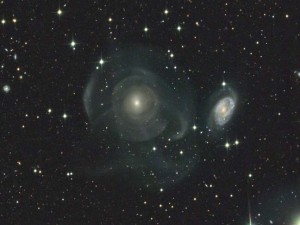
Fermi bubbles are now being acknowledged as coming from the galactic center, but astronomers are uncertain of the mechanism that produces them. They acknowledge that currently the galactic center is in a quiescent phase.
Interestingly, they now have a model for producing the sharp edges of the boundaries of the Fermi gamma ray bubbles, near the shock fronts. Is this in agreement with superwave propagation models?
http://www.physorg.com/news/2011-12-black-hole.html
Though we may have already been inside what is known as the Local Interstellar Cloud for tens or hundreds of thousands of years, scientists have been discussing regional areas, aka “cloudlets”, of variable density that we may have entered into as recently as the 1990’s. For example, on this Nasa article from Jan 2003:
A good collection of articles with brief summaries on this phenomenon is here:
http://www.susanrennison.com/Joyfire_Interstellar_Cloud_Index.php
There seems to be a large overlap here with your theories about the galactic superwave and its chain-reaction effects on the solar system, to the Sun, to our Earth, and being recorded in the ice core samples. A couple questions come to mind:
* How likely is it that the solar system’s movement through these variable density clouds affect the Sun and Earth in a way similar to how a superwave would do, and thus also lead to the extra-terrestrial chemical samples found in the ice core? Is it fair to say that possibly some of the ice core samples could be evidence for this kind of “compression” of the Sun’s heliosphere/magnetic field/etc. by these cloudlets?
* Do you have any general thoughts on the reality/significance of the Local Interstellar Cloud and these cloudlets with respect to its effects on our solar system/Sun/Earth/human bodies/minds?